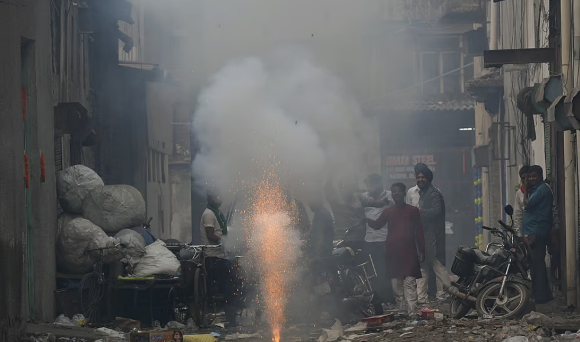Delhi floods aftermath: After the deluge, come disease and disorder
NEW DELHI,JULY 24: Two weeks ago, the incessant rain and floods thereafter brought the national capital to its knees. Thousands were rendered displaced and homeless after the Yamuna broke 45 years’ record and reached a record high of 208.66 metres, much above the last great flood in Delhi in 1978 – when it had reached 207.49 metres. The water entered the city and inundated many low-lying areas of East, North-East and South-East Delhi.
Yamuna, before its course changed, used to flow by the ramparts of the Red Fort and was once again flowing there. According to the Delhi government records, the authorities rescued nearly 27,000 people affected from flood-affected areas as water submerged their homes, shops and establishments.
Now that the flood water from low-lying areas is gradually receding, a new calamity is waiting to attack the city – public health crisis. Waterlogging and stagnant water are favourable conditions for growth of mold, bacteria and mosquito breeding. Delhi’s civic agencies are now focused on tackling flood aftermath and preventing a public health crisis by unveiling its action plan that involves involve use of surveillance drones and fumigation, awareness announcements in Delhi Metro premises, and a 24×7 control room to keep diseases under check.
Separately, the Municipal Corporation of Delhi (MCD) in a statement said that its veterinary department has removed carcasses of more than 1,300 animals from flood-affected areas over the last two days, and deployed over 10 mobile dispensaries to prevent the outbreak of water-borne diseases.
Health experts said that if left unchecked, the impending crisis after the flood can lead to medium and long-term health impacts, including water and vector-borne diseases, such as cholera, typhoid and malaria.
Delhi health minister Saurabh Bharadwaj had said recently that after floods, there is a fear of the spread of vector-borne diseases like dengue, chikungunya and malaria rising. For days, several parts of Delhi were flooded. People residing in low-lying areas like Yamuna Bazaar, Kashmere Gate, and ITO were forced to flee their flooded homes, leaving behind their belongings and forced to live on the streets or in relief camps.
As thousands of residents are yet to go back to their homes, sanitation at relief camps has become a major concern. Whereas, people still living in flood-affected areas are at risk of invasion of mice, snakes and insects.
Dr Mukesh Nagar, medical officer at Centre-run Safdarjung Hospital has been holding medical camps for flood-affected victims since the deluge hit the city. Nagar said that 80 per cent of the patients coming into his camp exhibit symptoms of conjunctivitis — an eye infection caused due to unhygienic conditions. “From there (relief camps), it’s now spreading to other parts of the city,” he added.
Nagar also said that almost all flood victims suffered injuries in their legs which they could have sustained while rescuing themselves and extracting their belongings.
Professor (Dr) Sanjay Roy, HOD, community medicine, AIIMS, said the authorities have two challenges in handling the aftermaths of the floods. “There are two concerns in the aftermath of floods. One is tackling immediate problems like saving human lives, livestock and rehabilitation. Then after we achieve this, the problem of providing safe and hygienic living conditions becomes the next challenge.”
“The first strategy to deal with post-trauma of floods is ample provision and access to safe drinking water. Children tend to play in a waterlogged area which is basically a backflow of sewage water. No access to water also forces people to wash utensils and clothes in the same water. So it should be the top priority of the authorities that they provide safe water to the affected families,” he added.
Roy said that the contaminated water is the genesis of the outbreak of vector-borne and water-borne diseases and relief camps provide perfect settlement for such outbreaks.“The flood water is basically the sewage that didn’t flush away. It contains life-threatening chemicals which provide a breeding ground for a host of communicable diseases and with overcrowded relief camps, it becomes the ticking bomb for an outbreak of a disease. So the threat of an epidemic is higher in such a situation,” he explained.
Dr Manali Agarwal, senior doctor at microbiology department of AIIMS, concurred. “Flood water can be heavily contaminated with sewage and other pollutants. It can cause sickness and infections. Outbreaks of vomiting and diarrhea tend to happen and various bacteria, parasites and viruses can spread as homes lose electricity, people gather together in close spaces and access to clean water becomes limited,” she said.
“E.Coli, including intestinal bacteria such as salmonella and shigella; Hepatitis A; and agents of typhoid, paratyphoid can cause severe illness. Symptoms generally include nausea, vomiting, diarrhea, abdominal cramps, muscle aches and fever. The most common source of illness during a flood is through consuming contaminated food or water. One must seek medical attention and treat open wounds right away,” she added.
Dr Anurag Saxena, HOD-internal medicine, Primus Super Speciality Hospital, warned that floods can have significant health implications, both in floodplains and urban areas, and the situation in Delhi should not be taken lightly. “Standing water from floods provides breeding grounds for mosquitoes, which can transmit diseases like malaria, dengue fever, and chikungunya. Health facilities should be well-equipped to handle potential outbreaks of waterborne and vector-borne diseases, and public health campaigns should be conducted to educate the public on preventive measures,” he said.
Apart from the loss of life and damage to property, history shows that floods have resulted in various public health issues. A study on the aftermath of floods show that injuries and communicable diseases are common short-term health consequences post floods, while malnutrition, poor birth outcomes, and mental health issues are some of the long-term consequences.
Dr Aniket Sirohi, HOD, public health, MCD, said, “There are many issues the survivors face. The first shock is the loss of habitat. People lose their surroundings, land, property, belongings and their routine lives. Children can’t go back to school till rehabilitation is done. Besides, scarcity of food and clean drinking water in camps puts them at a risk of malnutrition and dehydration severely impacting their immunity,” he said.
An essay published in the Royal Society of Tropical Medicine and Hygiene assessing devastating floods occurred in Kerala in 2018 and 2019 also sheds light on the long term including the ignored aspects of public health in such a situation. Following the flood, cases of leptospirosis, dengue fever, malaria and diarrhoea were reported there. Disrupted food supply and contaminated water made a significant effect on the health of the children in Kerala.
“Following the flood, girl children are more likely to have stunted growth and underweight as compared to their male peers. This difference has probably occurred due to gender discrimination in feeding practices, which give priority to the male child’s nutritional requirements. The financial status of the family can also play a role in undernutrition, as this study indicated that the negative impact of the flood was felt more acutely among children of mothers from a lower socio-economic background,” the essay read.
Experts suggest that after floods, a majority of public funds are directed towards relief packages, rebuilding of irrigation and sanitation systems, and reconstruction of houses. With limited resources, public health issues do not receive adequate attention. Interventions, whenever present, should be designed to improve nutrition for children, especially children of mothers from a lower socioeconomic background, said Sirohi.
Mental health issues such as post-traumatic stress disorder (PTSD), depression, and anxiety are common among survivors of floods. In a lower middle-income country such as India, resources to deal with mental health issues are scarce. In Kerala, 48 per cent of residents from flood-affected areas were diagnosed with depression. The geriatric population showed a higher prevalence of depression, according to the study.
“PTSD is a mental health issue that is frequently diagnosed following a natural disaster. Displacement from homes, loss of personal belongings, and the trauma of experiencing a natural disaster can lead to stress, anxiety, and depression among affected individuals,” said Dr Saxena.“Mental health is also a big concern especially in elderly and pregnant women,” said Dr Roy.
Diseases and infections one needs to look out for
Waterborne diseases : Typhoid fever, hepatitis A, and cryptosporidiosis
Vector-borne diseases: Still water post floods provide breeding grounds for mosquitoes, causing malaria, dengue fever, chikungunya, and Zika virus
Leptospirosis: This bacterial disease is often associated with floods and can be contracted through contact with water contaminated with the urine of infected animals
Respiratory infections: Mold growth on damp walls and the release of airborne allergens and irritants, leads to respiratory issues such as asthma exacerbations and allergic reactions
Gastrointestinal infections: Cholera, dysentery, gastroenteritis, and E.Coli infections are common. Symptoms are diarrhea, vomiting, abdominal pain, and dehydration
Skin infections: Fungal and bacterial skin infections. Skin contact with polluted water can also lead to rashes and irritation
Wound infections: Floods can cause injuries and wounds, and these wounds can become easily infected due to exposure to dirty water and lack of proper wound care
Mental health issues: Psychological impacts of a trauma can lead to anxiety, depression, post-traumatic stress disorder (PTSD), and other mental health issues
Heat-related illnesses: Hot and humid climate can increase the risk of heat exhaustion and heatstroke, especially if access to safe drinking water and cooling facilities is limited.
-PTI






